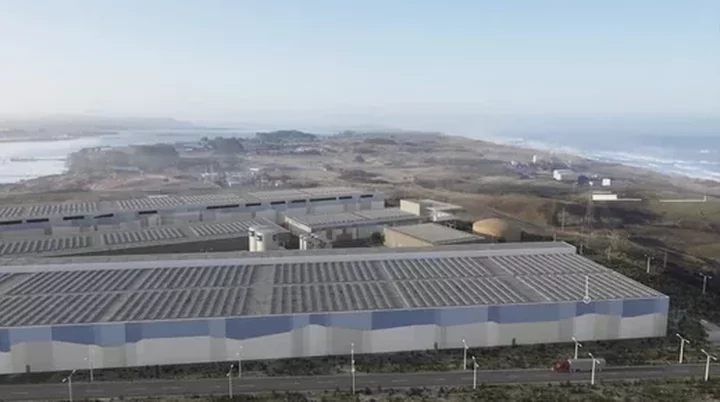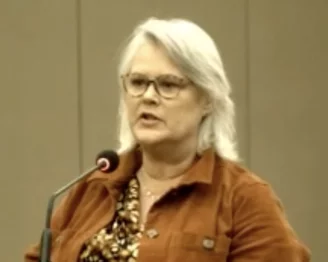Architectural mock-up of the land-based fish farm Nordic Aquafarms plans for the Samoa Peninsula.
###
Nordic Aquafarms has cleared yet another hurdle in the extensive permitting process for its land-based fish farm planned for the Samoa Peninsula. During today’s monthly meeting, the California Coastal Commission unanimously approved a coastal development permit, with special conditions, for wastewater discharge for the proposed project.
The Norwegian seafood company plans to raise yellowtail kingfish at the massive aquaculture facility, which would discharge more than 10 million gallons of “tertiary treated wastewater” per day through the existing Redwood Marine Terminal II outfall pipe located 1.55 miles offshore. To put that into perspective, when the Samoa Pulp Mill was operational it would produce 70 million gallons of untreated wastewater per day, according to Coastal Commission staff.
“The proposed discharge has the potential to adversely affect several coastal resources, including water quality and fisheries,” according to the staff report. “However, a review of available information by Commission staff indicates that such effects would be unlikely. A dilution study commissioned by Nordic found that water quality targets for salinity, ammonia, and temperature would all be met within no more than five feet of the outfall pipe’s diffuser array. The dilution study also found that nitrates, the largest constituent in the discharge, would reach the same concentrations as background coastal waters fifty percent of the time in the immediate vicinity of the diffuser.”
In staff’s projected worst-case scenario, the “discharge plume” could extend up to 1.5 kilometers, or 0.93 miles, away from the diffuser array, but it would not enter Humboldt Bay or other sensitive marine areas, according to the report. “Moreover, the rapid dilution of nutrients expected to occur in coastal waters would reduce the likelihood of eutrophication, hypoxia, and harmful algal blooms.”
The staff report includes five special conditions to further reduce potential impacts on water quality and coastal fisheries through extensive monitoring and review.
Brenda Chandler, chief executive officer for Nordic Aquafarms, spoke in favor of staff’s recommendation, adding that Nordic would be willing to implement the special conditions requested by Coastal Commission staff.
“We rely [on] and must preserve the very marine resource that your commission is tasked to protect. Our values are aligned,” she said. “We think that locating the farm in the coastal zone makes sense and [would be] an excellent use of the property. [It would] provide for further cleanup of the land, modernize the stormwater systems and provide water monitoring, as mentioned, two years before and after we start to discharge.”
Chandler noted that Nordic has held over 50 site tours and hundreds of public meetings since the project’s inception, all of which have allowed Nordic to “make this a better project.”
“These interactions truly have molded and shaped what you see today,” she said. “We may not have always agreed with one another, but we have certainly always listened.”
Speaking on behalf of the Humboldt Bay Harbor, Recreation and Conservation District during the public comment portion of today’s meeting, outgoing Executive Director Larry Oetker underscored the district’s “strong support” for the project.
“The former [Samoa] Pulp Mill is one of the most contaminated pieces of property on the entire California coast, and it also contains a host of blighted buildings. … Nobody would touch it with a 10-foot pole,” Oetker said. “[When] we acquired this property [in 2013], we set out a vision for how could we adaptively reuse this property and clean up the contamination. And at the end of the day, aquaculture was the primary anchor tenant that we felt like we could [host] … .”
Jennifer Kalt, executive director of Humboldt Waterkeeper, spoke on behalf of the Surfrider Foundation, the Northcoast Environmental Center and the Environmental Protection Information Center (EPIC), and offered her support for the permit application. She credited Nordic for its “commitment to 100 percent renewable energy” and the company’s “willingness to discuss, negotiate and compromise” throughout the project development process.
“We view the project’s potential impacts along with its benefits – namely that it would begin by removing contaminated structures, including the smokestack and chemical tanks abandoned in 2008 by the pulp mill that operated there since the 1960s,” Kalt continued. “We strongly support staff recommendations, and we urge you to approve the [coastal development permit] with special conditions.”
Scott Frazer, a representative of Citizens Protecting Humboldt Bay, asked the commission to table its decision on the permit application until after next month’s appeal hearing.
Citizens Protecting Humboldt Bay, an informal group of local residents, sued the County of Humboldt and the Board of Supervisors last year following the board’s decision to uphold the Planning Commission’s decision to certify Nordic’s Environmental Impact Report and approve a coastal development permit for the project. The group subsequently filed five appeals with the Coastal Commission that challenge the county’s issuance of a Coastal Development Permit.
“The action proposed today should be delayed until after the five appeals of the [permit] approval by Humboldt County have been heard by your commission,” Frazer said. “Additionally, the approval by Humboldt County of the Nordic Aquafarms [permit] has been contested at every administrative level, and is now subject to litigation in Superior Court due to numerous California Environmental Quality Act (CEQA) statute violations.”
Following public comment, Commissioner and Third District Humboldt County Supervisor Mike Wilson provided a bit of background on the defunct pulp mill site and how it has evolved in the last decade. “There’s been a lot of work that’s been done on this site,” he said, adding that more than $22 million has been spent on clean-up efforts since the Harbor District acquired the property in 2014.
Speaking specifically to outfall impacts associated with the project, Wilson said there are already aquaculture facilities operating at the site, including Coast Seafood’s oyster farming project.
“Are we talking about something that will that could have an impact? Sure. We have to talk about the significance of that, and I think staff has talked about that pretty specifically,” Wilson said. “I will say, when we say it’s massive, it is probably the biggest indoor [aquaculture] facility maybe on the planet. I mean, it’s only 30 acres, right? But if you do outdoor fish farming, then they can be hundreds of acres and they’re all over the place. This [project] is very unique in that space.”
Wilson also expressed support for the additional monitoring requirements implemented by Coastal Commission staff.
Commissioner Justin Cummings thanked staff for bringing forward recommendations “that minimize environmental impacts to the greatest extent possible.”
“To Commissioner Wilson’s point, there are going to be impacts and trade-offs, but I think for this – especially because it’s taking a former brownfield site, something that’s been heavily contaminated and putting it to a new use – I think that this is a really great model project,” Cummings said.
Commission Chair Donne Brownsey also expressed support for staff’s recommendation, adding that it is “encouraging to see present and future industries being proposed with elements, conditions and requirements that were not present in the past.”
After a bit of additional discussion, Cummings made a motion to approve staff’s recommendation, along with the special conditions listed in the staff report. Wilson seconded the action.
The motion passed with a unanimous 12-0 vote.
###
PREVIOUSLY:
- Massive New Fish Farm in the Works for Samoa Peninsula; Harbor District Expected to Bless Project Helmed by Norwegian Firm at Special Meeting Monday
- Humboldt Baykeeper Says: Samoa Fish Farm Proposal Looks Good So Far, But the Devil Will Be in the Details
- Let’s Take a Closer Look at This Big Fish Farm Proposal for the Samoa Peninsula
- In a Surprise Move, Nordic Aquafarms Agrees to Conduct Full Environmental Impact Report for Its Land-Based Fish Farm on the Samoa Peninsula
- Planning Commission Set to Consider Permits for Nordic Aquafarms Project Tonight
- Fishermen and Conservation Groups Appeal Nordic Aquafarms’ Environmental Report Certification to Humboldt County Supervisors
- Nordic Aquafarms Celebrates ‘Monumental Step Forward’ After Supes Deny Project Appeal
- Salmon OUT, Yellowtail IN: Nordic Aquafarms Announces Species Switch-Up at its Planned Humboldt Facility
- Water Quality Board Awards Wastewater Discharge Permit for Nordic Aquafarms’ Planned Peninsula Facility


CLICK TO MANAGE